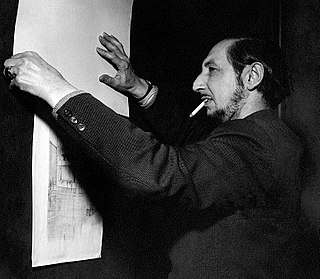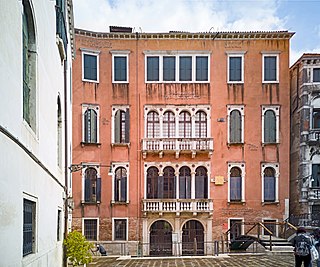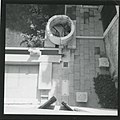
Carlo Scarpa was an Italian architect and designer. He was influenced by the materials, landscape, and history of Venetian culture, as well as that of Japan. Scarpa translated his interests in history, regionalism, invention, and the techniques of the artist and craftsman into ingenious glass and furniture design.

Ca' Foscari, the palace of the Foscari family, is a Gothic building on the waterfront of the Grand Canal in the Dorsoduro sestiere of Venice, Italy.

Ca' Rezzonico is a palazzo and art museum on the Grand Canal in the Dorsoduro sestiere of Venice, Italy. It is a particularly notable example of the 18th century Venetian baroque and rococo architecture and interior decoration, and displays paintings by the leading Venetian painters of the period, including Francesco Guardi and Giambattista Tiepolo. It is a public museum dedicated to 18th-century Venice and one of the 11 venues managed by the Fondazione Musei Civici di Venezia.

Pietro Longhi was a Venetian painter of contemporary genre scenes of life.

The Gallerie dell'Accademia is a museum gallery of pre-19th-century art in Venice, northern Italy. It is housed in the Scuola della Carità on the south bank of the Grand Canal, within the sestiere of Dorsoduro. It was originally the gallery of the Accademia di Belle Arti di Venezia, the art academy of Venice, from which it became independent in 1879, and for which the Ponte dell'Accademia and the Accademia boat landing station for the vaporetto water bus are named. The two institutions remained in the same building until 2004, when the art school moved to the Ospedale degli Incurabili.

The Pinacoteca Querini Stampalia is an art collection and museum in Venice, Italy. Situated inside the Palazzo Querini Stampalia, in the sestiere of Castello, on the left bank of the Grand Canal, it includes famous paintings as a self- portrait and Adam and Eve by Palma Giovane, a Sacra Conversazione by Palma Vecchio and a Madonna and Child by Bernardo Strozzi. It also holds prized drawings by Giovanni Bellini, Raphael, Paolo Veronese, Titian, and Tintoretto.

Iuav University of Venice is a university in Venice, Italy. It was founded in 1926 as the Istituto Universitario di Architettura di Venezia as one of the first architecture schools in Italy. The university offers several undergraduate, graduate and higher education courses in architecture, urban planning, fashion, arts, and design.

Luigi De Giudici was an Italian painter of the Venetian anti-academic movement in the first years of the twentieth century. His works were exhibited at Ca' Pesaro between 1912 and 1920 and at the International Exposition of Paris (1937).

The Ateneo Veneto di Scienze, Lettere ed Arti is an institution for the promulgation of science, literature, art and culture in all forms, in the exclusive interest of promoting social solidarity, located in Venice, northern Italy. The Ateneo Veneto is made up of 300 members resident in the city and in the province of Venice, elected by the Assembly, which is also responsible for appointing the chairman and the academic council. Honorary, Non-Resident and Foreign Members, elected by the Assembly also participate in the life of the Ateneo.

Ettore Tito was an Italian artist particularly known for his paintings of contemporary life and landscapes in Venice and the surrounding region. He trained at the Accademia di Belle Arti in Venice and from 1894 to 1927 was the Professor of Painting there. Tito exhibited widely and was awarded the Grand Prize in painting at the 1915 Panama–Pacific International Exposition in San Francisco. In 1926 he was made a member of the Royal Academy of Italy. Tito was born in Castellammare di Stabia in the province of Naples and died in Venice, the city which was his home for most of his life.
Pietro Querini was a 15th-century sea captain from the Republic of Venice. He is known for being shipwrecked at Røst in northern Norway during the winter of 1432, and subsequently returning to Venice, where he wrote a report of his travels for the Venetian Senate. He is also dubiously credited with popularizing stockfish in the Veneto region, where it is prepared as baccalà alla vicentina.

Eugenio Da Venezia was an Italian painter. He was a member of the group known as I Giovani di Palazzo Carminati. This group rejected the prevailing style of the Italian Academy at the beginning of the 20th century. Da Venezia painted in a post-impressionist style, influenced by the Venetian tradition of the vedutisti. He exhibited in ten editions of Venice Biennale between 1934 and 1956, including the XL anniversary in 1935.

The Murano Glass Museum is a museum on the history of glass, including local Murano glass, located on the island of Murano, just north of Venice, Italy.

Ferruccio Bortoluzzi was an Italian modern painter, he was one of the founders of the Centro di Unità della Cultura L'Arco together with venetian artists and writers.

The Provveditore Generale da Mar was the most senior peacetime office in the Venetian navy and in charge of governing the Venetian overseas empire.
Ferdinando Ongania was a Venetian publisher and bookseller best known for publishing the monumental book La Basilica San Marco in Venezia. Ongania published more than 170 books, mainly about Venice. He was particularly significant for using the latest photographic techniques to create facsimile editions and reproductions of great Venetian artworks. In particular, his heliographic prints were remarkable for their clarity. He published out of his antique shop and gallery on Piazza San Marco, which catered to an international clientele.

Supper in the House of Simon the Pharisee is a 1544 oil on canvas painting by Moretto da Brescia, now in the Chiesa della Pietà in Venice, Italy.
Giuseppe Fiocco was an Italian art historian, art critic, and academic. He is known for his research and writings on Venetian and Florentine artists.
























